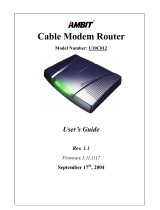
15
To release and renew the IP address for the Windows 2000 and
Windows NT 4.0 operating system:
1 Click Start and select Programs, then Accessories.
2 Click Command Prompt.
3 At the command prompt (C:\), type ipconfig/release. Windows releases
the IP address.
4 At the command prompt type ipconfig/renew. Windows renews the IP
address.
5 At the command prompt (C:\), type exit and press Enter to return to the
Windows desktop.
Problem: “All of the LEDs on the front of my cable modem look right,
but I cannot access the Internet.”
1 If the Power, Cable, Status, and Eth (LEDs) are lit and not blinking the cable
modem is operating properly. Try shutting down the computer and then
turning it back on. This will cause the computer to re-establish
communications with your local cable provider.
2 Power cycle the cable modem by removing the power adapter from its
outlet and then plugging it back into the outlet. Wait several minutes for the
cable modem to re-establish communications with your local cable
operator, then try accessing the Internet.
3 Verify that you have installed TCP/IP properly (for Windows 95, Windows
98, Windows 98SE, and Windows Me: winipcfg; for Windows 2000:
ipconfig), and that the TCP/IP parameters provided by your local cable
provider are correct for your computer.
4 If you are using a cable line splitter so that you can connect the cable
modem and a television to the same outlet:
a Try removing the splitter and reconnecting the cables so that the
cable modem is connected directly to the cable wall jack.
b Wait several minutes, then try accessing the Internet.
Problem: The power on my cable modem goes on and off sporadically.
You may be using the wrong power adapter. Check that the power adapter
you are using is the one that came with the cable modem.
CAUTION! You must use the 12VDC/1.25A power adapter that comes with
the D-Link DCM-202 cable modem. Using the wrong power adapter can
damage the cable modem.






















